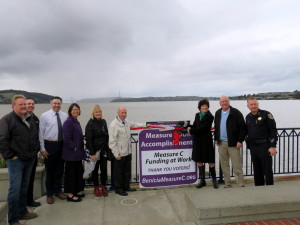
(Left to right) Parks and Community Services Superintendent Rick Knight, Parks Director Mike Dotson, Economic Development Manager Mario Giuliani, City Attorney Heather McLaughlin, former Councilmember Christina Strawbridge, Councilmember Alan Schwartzman, Mayor Elizabeth Patterson, Councilmember Mark Hughes and Police Chief Erik Upson cut the ribbon for the new promenade railing along First Street back in January. (Photo courtesy of Kate Gibbs)
By Mario Giuliani
Special to the Herald
With these past few days of sunshine you may have had the opportunity to stroll down First Street. If so, you likely have observed crews working to repair areas of sidewalk. If your walk took you to the end of First Street, you may have leaned upon the new promenade railing as you looked out on to the Carquinez Strait. If you walk down First street next month, in April, you will see crews repaving First Street. All of this work is because of the community’s support of Measure C.
Recall that Measure C is a local 1 percent “general tax” passed by Benicia voters in November 2014. “General Tax” has a specific meaning in the state of California; for our purposes it means that all proceeds collected from this tax go to the city’s general fund. It further means that no city council can designate into perpetuity where those funds will be spent. For example, a city council cannot declare that all Measure C funds or a given percentage of those funds will always be spent on widgets, or conversely can never be spent on widgets. Rather, the city council during the adoption of each City budget can allocate where those funds are to be spent.
While the law precludes a city council from specifying where Measure C funds will go to in future years nothing prevents a city council from stating its preferences and priorities on where those dollars should be spent and then taking action by allocating those funds every two years. The city of Benicia adopts a two-year budget. This is what occurred in 2014 when the Benicia City Council established its allocation priorities for Measure C.
When the City Council proposed Measure C in 2014, it set forth its rationale for the measure and related spending priorities. Recall the primary purpose of Measure C was to address Benicia’s decreasing revenue by creating a new local funding stream to support existing services. In every resolution related to Measure C passed by the City Council and every informational mailer, and ballot argument it was highlighted that Measure C would support existing services. What does existing services mean? Today, like in 2014, it means keeping the library, pool and community center open and maintaining staffing levels for departments such as police, fire, public works, and parks and recreation. In addition to maintaining existing services, Measure C was designed to support improving city infrastructure and equipment, particularly in the areas of public safety, parks and roads. To that end, since Measure C went into effect in April 2015, the city has allocated over $10 million. Over $6 million of which has been invested in projects and equipment that include, $894,101 in public safety projects (fire engines, police cameras and radios), $2,259,306 in new park equipment and $2,805,000 on roads and sidewalk projects.
Moving forward, in the coming months, the City Council will be discussing the various city needs, priorities, and projects that could be funded with the adoption of the 2017-2019 City Budget. As part of that process the City Council will allocate the proceeds of Measure C for the next two years. The city budget will be adopted in June. Now is a great time to become engaged in the budget process and offer your thoughts on our city’s needs, priorities, and projects that could be funded from proceeds of Measure C. To get engaged you can write to the City Council or offer public comment during City Council meetings or participate in the various city boards or commissions.
To learn more about the city, please visit http://www.ci.benicia.ca.us. For more information on Measure C, you can visit BeniciaMeasureC.org.
Mario Giuliani is Benicia’s economic development manager and acting deputy city manager.






Leave a Reply